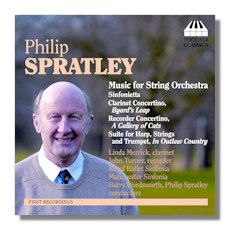
The Internet's Premier Classical Music Source
Related Links
- Latest Reviews
- More Reviews
-
By Composer
-
Collections
DVD & Blu-ray
Books
Concert Reviews
Articles/Interviews
Software
Audio
Search Amazon
Recommended Links
Site News
 CD Review
CD Review
Philip Spratley

Music for String Orchestra
- Sinfonietta, Op. 6 *
- Clarinet Concertino "Byard's Leap", Op. 27
- Recorder Concertino "A Gallery of Cats", Op. 26
- Suite for Harp, Strings & Trumpet "In Outlaw Country", Op. 12b
Linda Merrick, clarinet
John Turner, recorder
Tracey Redfern, trumpet
Eira Lynn Jones, harp
Manchester Sinfonia/Philip Spratley
* Royal Ballet Sinfonia/Barry Wordsworth
Toccata Classics TOCC0088 2009 71:11
This is a very welcome release of pleasurable (and in keeping with Tocccata's core aim) previously unrecorded music. Spratley (b. 1942) has been working in obscurity for many years in Lincolnshire and his catalog is small as his "philosophy is simple. Compose only when you really have to…when the time is absolutely right" Presumably he is referring to an inner compulsion because composition has surely not been his financial livelihood. Spratley began playing the organ in Coddington Church at age 15, which "kept [him] going as school was not very enjoyable…" He sang in choir before that. He attended the Royal Manchester College of Music on scholarship. Later he taught instrumental playing and spent two decades as Director of Music at Bourne Abbey. Spratley wrote two operas, one of which received production at three local venues. His violin concerto has never been performed. The Suite on this recording was written for large orchestra but after thirty years passed without a performance he re-wrote it for small ensemble, with two new movements substituted for old ones. The diminutives in the titles of the other pieces seem revealing of modest expectations on the composer's part. So it is very gratifying that, thanks to Toccata, this fine composer may finally be getting some of the wider recognition he deserves.
This music is being recorded on its merits. It is quite good, unpretentious but generally delightful and sometimes even surprising. Beautiful even. The idiom is quite conservative, rooted in part in English folksong, but it sounds fresh to the ear, is generally forward moving, melodically inventive and rhythmically satisfying. The selection here is varied. Despite the title of the release, the strings accompany, or are augmented by, clarinet, recorder, trumpet, timpani and harp. In his notes, Spratley suggests some musical scene painting but I would recommend hearing it as absolute music.
The four movement Sinfonietta, at twenty-six and a half minutes, is the longest piece here. The opening movement is marked "Pezzo poco serioso," a designation not so easy to make out, especially since the finale is marked "Pezzo meno serioso." One way to read the Italian might be that the first movement has some seriousness; another is that it is not very serious and the final one even less so. The opening movement does display some intensity and perhaps even a bit of poignancy just at the end, but both movements seem pretty upbeat to me so maybe there is a bit of tongue in cheek here. The Arioso is indeed songful. As for the Scherzo, if I were judging some kind of competition among works with that designation, this would be a contender; Spratley even means the trio section to be humorous. Spratley revised this work many times before it took final form in 1987 – eleven years before its first performance.
The melodic Clarinet Concertino, composed in the early 1980's and revised in 2008, displays all registers of the solo instrument. The first movement is an "Andante pastorale," and the album blurb declares that this composer is "a true heir of Holst and Vaughan Williams." The second movement is marked "Larghetto e desolato" and it is not only predominantly pensive but contains quite an outburst, with percussion, prior to returning to a calmer manner. The finale is lively.
The seven movement Recorder Concertino has a slow movement marked "Lamentoso," in memory of a deceased pet, which is plaintive and with some dark lower tones, but without the intensity of the clarinet slow movement, except that it segues into the following "Ostinato," which is intense. Most of the movements are in baroque dance forms. This work uses four different recorders, all rather high in pitch: sopranino, soprano, treble, and tenor.
The Suite is in five movements: Preludio, Notturno, Scherzo, Lullaby, Finale. Fear not. The "outlaw" in the title is nothing like Billy the Kid; the music is simply meant to evoke Lincolnshire, Robin Hood country. The Notturno is quite beautiful, quiet and meditative with a light skipping passage. The Lullaby is appropriately restful, and there is another wonderful scherzo. The finale is lively. My only reservation concerns its final bar. I wish that he had avoided the very conventional last three notes, but in view of the general exuberance of the movement this can be forgiven.
Highly recommended.
Copyright © 2010, R. James Tobin





















